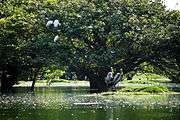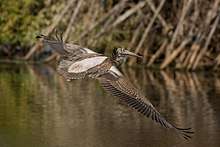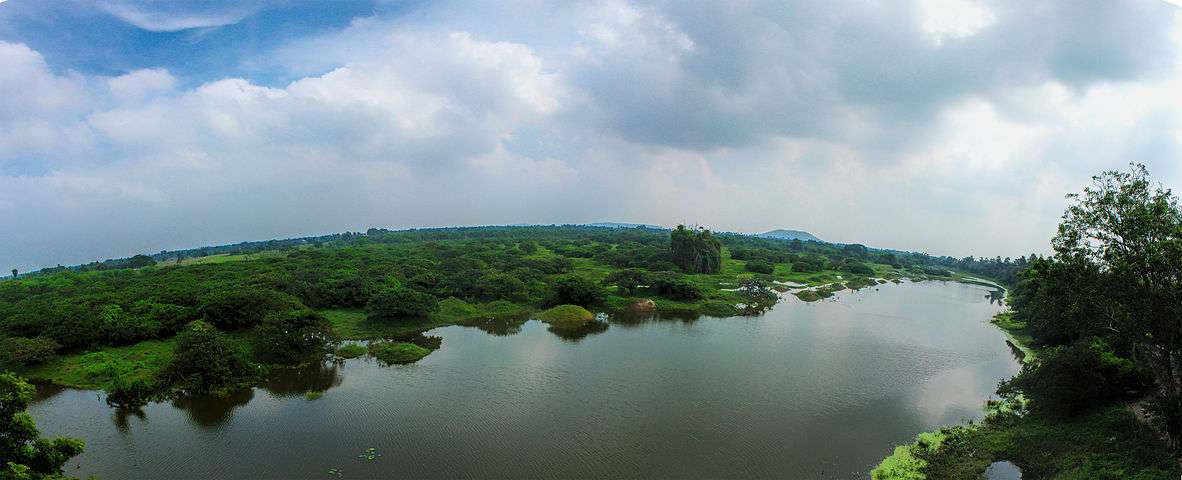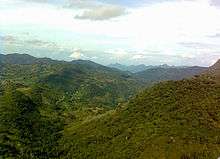Vedanthangal Bird Sanctuary
Vedanthangal Bird Sanctuary is a 30-hectare (74-acre) protected area located in the Chengalpattu District and Madurantakam taluk of the state of Tamil Nadu, India. The sanctuary is about 75 kilometres (47 mi) from Chennai on National Highway 45 ([NH45]). Easily reachable from Madurantakam and Chengalpattu. More than 40,000 birds (including 26 rare species), from various parts of the world visit the sanctuary during the migratory season every year.[1]
Vedanthangal Bird Sanctuary | |
|---|---|
nature reserving sanctuary | |
View of Vedanthangal Lake | |
 Vedanthangal Bird Sanctuary Location in Tamil Nadu, India | |
| Coordinates: 12°32′44″N 79°51′21″E | |
| Country | |
| State | Tamil Nadu |
| District | Chengalpattu |
| Established | 1936 |
| Area | |
| • Total | 0.3 km2 (0.1 sq mi) |
| Area rank | 323 |
| Languages | |
| • Official | Tamil |
| Time zone | UTC+5:30 (IST) |
| Nearest city | Chennai |
| Governing body | Ministry of Environment and Forests, Government of India |
Vedanthangal is home to migratory birds such as pintail, garganey, grey wagtail, blue-winged teal, common sandpiper and the like.[2]
Vedanthangal is the oldest water bird sanctuary in the country.[1][3] Vedanthangal in Tamil language means 'hamlet of the hunter'.[4] This area was a favourite hunting spot of the local landlords in the early 18th century. The region attracted a variety of birds because it was dotted with small lakes that acted as feeding grounds for the birds. Realising its ornithological importance, the British government undertook steps to develop Vedanthangal into a bird sanctuary as early as 1798. This was established in 1858 by the order of the Collector of Chengalpattu.
The best time to visit this sanctuary is from November to March. During this time, birds are seen busy building and maintaining their nests.
Villagers near this sanctuary are very concerned about the sanctuary and its winged residents, and they have taken many serious steps to avoid disturbance to the flow of birds.
History



The Vedanthangal lake bird sanctuary has a tradition of the people actively protecting birds coming to the area since time immemorial. The local people understood the relationship between birds and the productivity of their crops even before the concept of wildlife conservation came into vogue. They knew that the bird droppings in the water created guano which acted as fertilizer. Towards the end of the 18th century local villagers complained to the collector of Chengalpet Lionel Palace, about the British soldiers shooting the birds. They demanded and obtained a 'Cowle' from the collector (Mr Place, Collector of Chingleput 1796-1798[5]) to protect the birds. In 1936 the collector officially recognized the lake as a sanctuary. In 1962 it was given the legal status of reserved forest under the Madras Forest Act.
Several accounts of the sanctuary were published in the mid-19th century.[6][7] In 1936, the park was notified as a sanctuary, and in 1962, the Madras Forest Act legally accorded the status of a reserve forest to Vedanthangal. Ten years later, the place was declared as a wildlife sanctuary.
In the government order dated 8 July 1988, the area was declared as 'Vedanthangal Lake Bird Sanctuary', under the Wildlife Protection Act of 1972.
In 1967, a rest house was constructed for the convenience of visiting inspecting officers and tourists.
The area had a compact grove of more than 500 Barringtonia trees earlier. An additional 100 trees were planted in 1973 and over 1,000 trees were planted in 1996.
Bird species

The Vedanthangal Lake Bird Sanctuary features thousands of birds coming from various countries, some of which can be easily identified. Some easily found birds include cormorants, darters, grebes, large egrets, little egrets, moorhens, night herons, paddy birds, painted storks, pintails, pond herons, sandpipers, shovellers, terns, white ibises and many more. The migratory birds include garganeys and teals from Canada; snake birds and glossy ibises from Sri Lanka; grey pelicans from Australia; grey herons and openbilled stork from Bangladesh; painted storks from Siberia; spoonbills from Burma and the Indian spot-billed duck. It is a good tourist spot.


Location


The Lake
The Vedanthangal lake is situated 122 m above sea level. It supplies water to 250 acres of agricultural land around the area. The west and south sides of the lake are bordered by a long bund, whereas the northern and eastern sides extend to the agricultural lands. Input of water into this lake is through four small canals. Maximum depth of the lake is 5 metres. The area receives an average annual rainfall of 1400 mm, mostly from the north-east monsoon.[3]
Flora and fauna

Flora: Barringtonia acutangula, Acacia nilotica, and Alangium salviflorum trees and dry evergreen scrub and thorn forests.
Fauna: monkeys and other common mammals can be spotted.
Birds: garganey, teal, glossy ibis, grey heron, grey pelican, open-billed stork, painted stork, snake bird, spoonbill, spot bill duck, cormorants, darter, grebes, large egret, little egrets, moorhen, night herons, paddy bird, painted stork, pintails, pond heron, sandpiper, shovellers, terns, white ibis. They migrate from Europe during November and December to escape the frost that sets in.
Vedanthangal Bird Sanctuary
List of birds
The breeding waterbirds found at the Vedanthangal bird sanctuary are:[8]
- Grey Pelican Pelecanus philippensis
- Large Cormorant Phalacrocorax carbo
- Indian Shag Phalacrocorax fuscicollis
- Little Cormorant Microcarbo niger
- Darter Anhinga rufa
- Grey Heron Ardea cinerea
- Large Egret Ardea alba
- Smaller (Median) Egret Egretta intermedia
- Little Egret Egretta garzetta
- Night Heron Nycticorax nycticorax
- Openbilled Stork Anastomus oscitans
- Black-headed Ibis Threskiornis melanocephalus
- Spoonbill Platalea leucorodia
 Grey pelican, painted stork, little egret and open-billed stork
Grey pelican, painted stork, little egret and open-billed stork Indian pond heron
Indian pond heron Black headed ibis
Black headed ibis Golden oriole
Golden oriole Openbilled stork
Openbilled stork Male and female parakeet
Male and female parakeet Spot billed duck
Spot billed duck Darter and ibis
Darter and ibis Pond heron and its reflection
Pond heron and its reflection Egret landing on an island
Egret landing on an island
Conservation

Several steps have been taken by the Government of Tamil Nadu to protect the area. Water channels have been built by the Public Works Department to facilitate water supply to the sanctuary from neighbouring lakes.[1]
In 2013, two lakh Barringtonia saplings were planted in the sanctuary to allow birds to nest. The Vedanthangal lake was also desilted and deepened to hold more water.[1]
 Full View of Vedanthangal bird sanctuary
Full View of Vedanthangal bird sanctuary Vedanthangal bird sanctuary Entrance
Vedanthangal bird sanctuary Entrance Full View of Vedanthangal bird sanctuary from Watch Tower
Full View of Vedanthangal bird sanctuary from Watch Tower
References
- D, Madhavan (18 November 2013). "Bird sanctuaries to open on Friday". The Hindu. Chennai.
- Vedanthangal - M.Krishnan pg.9
- VenkatramanG; Thiyagesan K; Nagarajan R; Jyothinayakam, J.T. (1 January 2008). Wildlife Biodiversity Conservation: Proceedings of the "National Seminar on Wildlife Biodiversity Conservation", 13 to 15 October, 2006, a Seminar Conducted During the "bi-decennial Celebrations" of Pondicherry University. Daya Publishing House. pp. 93–. ISBN 978-81-7035-529-8.
- University of Chennai - Tamil Lexicon
- Bates, RSP (1931). Birdlife in India. Bombay Natural History Society.
- Shortt, John (1866). "Account of a heronry, and breeding-place of other water-birds, in southern India". Zoologist. 1: 11–16.
- Hume, AO (1889). The nests and eggs of Indian Birds. Volume 3. R H Porter. pp. 238–239.
- Santharam, V. and R. K. G. Menon. 1991. Some observations on the water-bird populations of the Vedanthangal Bird Sanctuary. Newsletter for Birdwatchers 31 (11-12): 6-8
External links
| Wikimedia Commons has media related to Vedanthangal Bird Sanctuary. |




